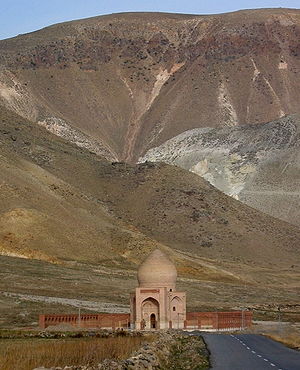Battle of Chaldiran
| date | August 23, 1514 |
|---|---|
| place | Northwest Iran near Tschaldiran, northwest of the city of Choi (in the Iranian province of West Azerbaijan) |
| output | Victory of the Ottoman Empire |
| Parties to the conflict | |
|---|---|
| Commander | |
|
Sultan Selim I. |
Shah Ismail I. |
| Troop strength | |
| 60,000 to 200,000 | 80,000 |
| losses | |
|
Unknown |
Unknown but difficult |
The Battle of Tschaldiran ( Persian چالدران Chaldiran , DMG Caldiran , Turkish Caldiran ) took place on 23. August 1514 near Chaldiran in eastern Anatolia between the Ottoman Empire under Sultan Selim I and the Safavids of the Persian Empire under Shah Ismail I. instead. It ended with a decisive victory for the Ottomans.
consequences
After the battle, Sultan Selim advanced on the Safavid capital Tabriz and conquered it. The Safavids had to move their capital to Qazvin . In 1598 the centrally located Isfahan became the capital. However, Tabriz could not be held permanently, as Selim I was finally forced to break off the campaign in the inhospitable mountains of today's Iranian province of West Azerbaijan because of the advanced season .
As a result of the battle, the Ottoman Empire gained control of eastern Anatolia with important cities such as Diyarbakir and Van . The borderline after the battle has remained almost unchanged to this day. The Safavids no longer posed a serious threat to the Ottomans for the next 100 years.
With the victory of the Ottomans, the Kurdish feudal lords and local princes switched sides. They turned their backs on the Safavids and protested their loyalty to the Ottomans. With the conquest of Eastern Anatolia, Sultan Selim I had created a basis for the later conquest of Mameluke Egypt and also gained control over a section of the Silk Road .
With the conquest of Eastern Anatolia, many followers of Shah Ismail I fled Anatolia. The remaining Turkmen tribes got on the defensive and with them Alevism . Sultan Selim I spread Orthodox Sunniism and is still not popular among Alevis today. After Ismail I had introduced Twelve Shiism as the state religion in 1501 , the Safavids turned to Orthodox Shiaism in the following centuries. With the relocation of the capital to Isfahan, the "Persian element" within the empire was considerably strengthened against the Turkmen military aristocracy ( Kizilbasch ). The defeat destroyed the belief that Shah Ismail I was the Mahdi , as he was invincible. After Ismail lost this status among the Kizilbash, rivalries broke out between the tribes after his death in 1524.
Web links
- Battle of Chaldiran . In: Ehsan Yarshater (Ed.): Encyclopædia Iranica (English, including references)
Individual evidence
- ↑ Keegan & Wheatcroft, Who's Who in Military History , Routledge, 1996. p. 268: “ In 1515 Selim marched east with some 60,000 men; a proportion of these were skilled Janissaries, certainly the best infantry in Asia, and the sipahis, equally well-trained and disciplined cavalry. [...] The Persian army, under Shah Ismail, was almost entirely composed of Turcoman tribal levies, a courageous but ill-disciplined cavalry army. Slightly inferior in numbers to the Turks, their charges broke against the Janissaries, who had taken up fixed positions behind rudimentary field works. "
- ↑ a b H.AR Gibb & H. Bowen, Islamic society and the West , i / 2, Oxford, 1957, p. 189
- ^ A b Roger M. Savory, Encyclopaedia of Islam , Safawids , Online Edition 2005
- ^ Martin Sicker: The Islamic world in ascendancy: from the Arab conquests to the siege of Vienna. Greenwood Publishing Group, Westport, Conn. 2000, ISBN 0-275-96892-8 , p. 197.


